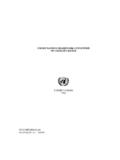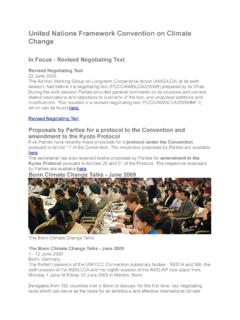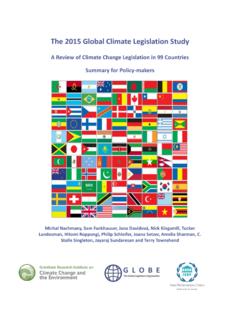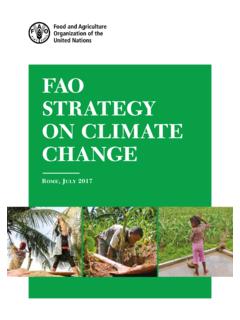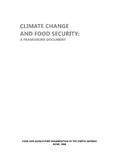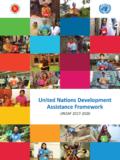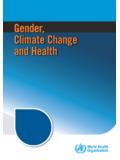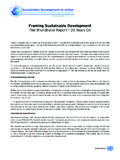Transcription of PROJECT LEVEL RESULTS FRAMEWORK AND BASELINE …
1 May 26, 2011 Adaptation Fund Board Fourteenth Meeting Bonn, June 20, 2011 PROJECT LEVEL RESULTS FRAMEWORK AND BASELINE GUIDELINE document 2 BACKGROUND At its tenth, the Adaptation Fund Board adopted the approach to implementing RESULTS based management (RBM), contained in Annex IV of the report of the 10th meeting of the Adaptation Fund Board. The Board also adopted the Strategic RESULTS FRAMEWORK for the Adaptation Fund and the Adaptation Fund LEVEL Effectiveness and Efficiency RESULTS FRAMEWORK of the RBM document . As part of the Board decision on moving forward with RBM, the Board requested the secretariat to develop a practical guide or manual on how PROJECT baselines and PROJECT RESULTS frameworks may be prepared.
2 The following document contains the finalized guidance document approved by the Board. The guidelines are meant as a tool for PROJECT proponents to utilize when designing PROJECT or program LEVEL RESULTS frameworks and developing baselines to submit to the Adaptation Fund. 3 GUIDANCE DOCUMENT1 INTRODUCTION Adaptation Fund: The Adaptation Fund (AF), established by the Parties to the UN FRAMEWORK Convention on Climate Change (UNFCCC), provides direct access to funds for concrete adaptation projects and programmes in developing countries that are Parties to the Kyoto Protocol. The total amount available for eligible developing-country Parties depends on the market-based monetization of Certified Emission Reductions (CERs), which are the AF's main source of revenue.
3 Eligible developing-country Parties seeking AF resources should adhere to the AF s Adaptation Fund s Operational Policies and guidelines ,2 including the following: Obtain the endorsement of a designated authority, chosen by the relevant Government; Include a BASELINE and a RESULTS FRAMEWORK /log frame with each final PROJECT submission;3 and Submit proposals through an accredited National Implementing Entity (NIE) or through Multilateral Implementing Entities (MIEs). Structure of this document : This manual helps potential applicants to the Adaptation Fund (AF) develop PROJECT or programme baselines and RESULTS frameworks (including data collection, analysis, and reporting on AF indicators).
4 It also lays out how to align RESULTS frameworks/logframes at the PROJECT LEVEL with the AF s Strategic RESULTS FRAMEWORK . Section 1 highlights RESULTS -based management and details the AF s strategic RESULTS FRAMEWORK ; 1 The present guidance document has been developed by extracting and adapting information from other guidance documents and documents from different international organizations and co-operation agencies (OECD, UNDP, IFAD, DANIDA, World Bank, USAID, IADB), in addition to other sources included as References ( , Measures of Success and How is your MPA doing guidebooks). 2 3 % Goals of this document : Briefly explain the Adaptation Fund s RBM FRAMEWORK ; Clarify AF core indicators, and suggest ways to measure them; and Suggest how to report outputs and outcomes.
5 This document does not: Provide guidelines to develop and analyze RBM frameworks; Provide tools for selecting and measuring PROJECT specific indicators; or Help set up or manage PROJECT monitoring and evaluation (M&E). 4 Section 2 shows how to compile and assess contextual and BASELINE data; Section 3 provides basic concepts about knowledge management (KM), and how it is integrated into the AF s RBM FRAMEWORK , and includes a short overview on how to develop a KM strategy; and Annex 1 describes the standard AF indicators and outlines how to define, measure, and collect data. SECTION 1: THE ADAPTATION FUND and RESULTS -BASED MANAGEMENT Chapter 1: Guiding Principles RESULTS -based management (RBM) provides a sound FRAMEWORK for strategic planning and management by improving learning and In RBM, the management strategy, as well as implemented activities, should reflect a commitment to accomplish planned For AF projects, the core of RBM is a RESULTS chain that shows the causal relationship between activities, outputs, outcomes, and impact over time.
6 Central questions of RBM include the following: How do PROJECT interventions and other activities contribute to desired outcomes? Why should we set meaningful performance expectations? How should we measure and analyze RESULTS ? How can learning from evidence help adjust delivery and modify or confirm PROJECT and programme design? How should we report performance achieved against expectations? A monitoring and evaluation (M&E) system must therefore be in place to assess PROJECT performance with respect to expected outputs, outcomes, and Adaptation Fund Strategic RESULTS FRAMEWORK The Adaptation Fund Strategic RESULTS FRAMEWORK includes the long-term goal, outcomes, outputs, and a small set of indicators for the Fund as a whole.
7 The Adaptation Fund works toward the achievement of the overall goal and outcomes. Consequently, any PROJECT or programme funded 4 OECD 2001 5 IFAD 2007 6 IFAD 2007 1. Key RBM Terms The RBM terms in this section reflect those of the United Nations Development Group (UNDG), and are in line with the Organization for Economic Co-operation and Development-Development Assistance Committee (OECD-DAC) definitions. RESULTS : Changes in a state or condition that derive from a cause-and-effect relationship. A development intervention can set three types of change into motion: output, outcome, and impact. Goal: The higher-order objective to which a development intervention is intended to contribute.
8 Impact: Positive and negative long-term effects on identifiable population groups produced by a development intervention. These effects can be economic, socio-cultural, institutional, environmental, technological or of other types. Outcome: The intended or achieved short-term and medium-term effects of an intervention s outputs, usually requiring the collective effort of partners. Outcomes represent changes in development conditions that occur between the completion of outputs and the achievement of impact. Outputs: The products and services resulting from the completion of activities within a development intervention. Assumptions (external factors or risks): Expectations about external factors (or risks) that could affect the progress or success of a development intervention, but over which the management has no direct control.
9 5 through the AF must align with the Fund s RESULTS FRAMEWORK and directly contribute to the overall objective and outcomes outlined. The RESULTS architecture for the Fund is framed as follows:7 Note: Each Outcome, Output and Indicator is hyperlinked. Control + Click on the link will bring you to the relevant section in the Annex. Control + G will allow you to return to your original location in the main document . Objective: Reduce vulnerability and increase adaptive capacity to respond to the impacts of climate change, including variability at local and national levels. EXPECTED RESULTS INDICATORS Goal: Assist developing-country Parties to the Kyoto Protocol that are particularly vulnerable to the adverse effects of climate change in meeting the costs of concrete adaptation projects and programmes in order to implement climate-resilient measures.
10 Impact: Increased resiliency at the community, national, and regional levels to climate variability and change. Outcome 1: Reduced exposure at national LEVEL to climate-related hazards and threats 1. Relevant threat and hazard information generated and disseminated to stakeholders on a timely basis Output 1: Risk and vulnerability assessments conducted and updated at a national LEVEL No. and type of projects that conduct and update risk and vulnerability assessments Development of early warning systems Outcome 2: Strengthened institutional capacity to reduce risks associated with climate-induced socioeconomic and environmental losses No. and type of targeted institutions with increased capacity to minimize exposure to climate variability risks Number of people with reduced risk to extreme weather events Output : Strengthened capacity of national and regional centres and networks to respond rapidly to extreme weather events No.










